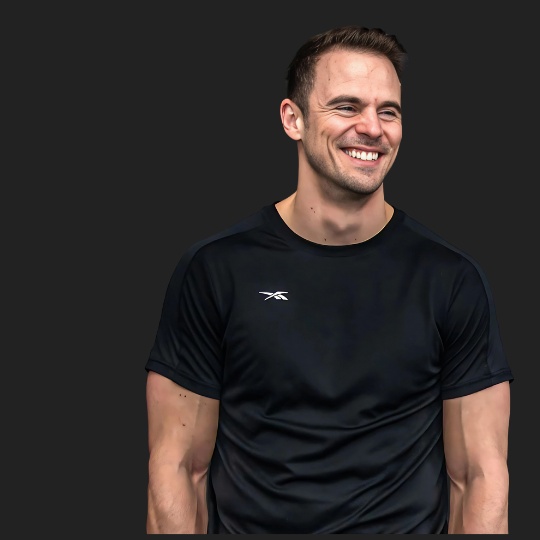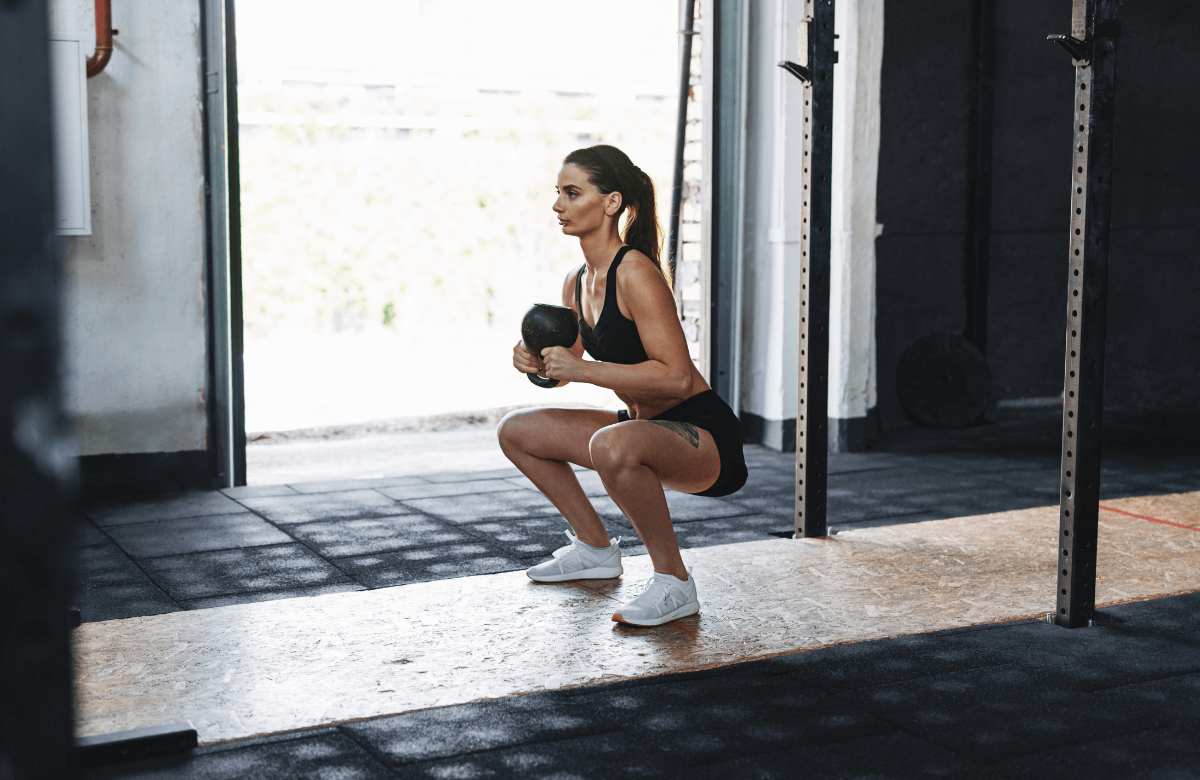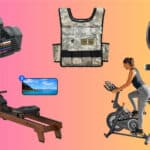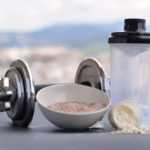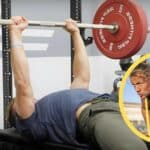One of the best things you can do in your training is compound exercises. These movements combine more than one muscle group, so you get more benefit out of the motion than you do from an isolation exercise.
The kettlebell thruster is one of those movements. It’s not something many people would think of doing themselves, but it’s a common CrossFit exercise for the exact reasons we mention above.
If you’re looking to get as much as possible out of your workouts, you may want to consider adding the kettlebell thruster to your routine. Here’s all you need to know about it!
Jump to:
What Is a Kettlebell Thruster?
A kettlebell thruster is a complex movement. It’s a combination of a kettlebell squat and a kettlebell overhead press, so it works pretty much the entire body!
The barbell thruster is the more well-known of the thruster exercises. But the kettle version is an alternative for those who may not have access to a barbell or who want a different kind of challenge.

What Muscles Does the Kettlebell Thruster Work?
One of the greatest things about this exercise is that it works a lotttt of muscles! Think of what a squat works and then what a shoulder press works… And put them together.
The squat portion of the exercise works the:
- Glutes
- Quads
- Hamstrings
And the press section works the:
A great combination of upper and lower body muscles get a workout with this simple movement. Apparently, the movement works over 600 muscles in total!

Benefits of Kettlebell Thrusters
This compound movement offers a ton of benefits, no matter which way you do it or how light a weight you use. Here are the benefits you can expect to gain when you start incorporating it into your workout routine.
Compound Exercise
Being a complex exercise is a huge bonus! It means that you work multiple muscles in both the upper and lower body, which helps you to gain strength faster and get more bang for your buck out of the movement.
It also means you tend to burn more calories during this particular movement than you do during others, as it requires a good bit more energy to perform than less complex movements. Take note that you won’t be burning hundreds more—maybe 10 or so—but over time, every little advantage adds up.
Unilateral Movement
The kettlebell thruster is a unilateral movement, which means you only work out one side of the body at a time. This sets the kettlebell thruster apart from the regular barbell thruster.
Why is this important? Unilateral exercises allow us to focus harder on training each side of the body separately, rather than getting both sides on one movement.
It stops the more dominant side of your body from taking over, which could leave you with muscle imbalances. On the other side of the coin, if you already happen to have imbalances, unilateral exercises help you to correct them.
Excellent Core Exercise
Another one of the amazing things about this exercise is that it works the core way more than you might expect. Due to the nature of the lift, your core needs to stabilize your body during the movement.
While you might feel it most in the obliques as you’re doing the exercise, it actually gives the core a very well-rounded workout. It’s essential to keep the core tight as you move through the thruster, so you’ll find that it contributes to your core strength as well.
Offers Cardiovascular Benefits
Because the kettlebell thruster uses so many muscles and can be quite an explosive movement, it tends to get your heart rate up quite a bit.
This can offer some cardiovascular benefits, more so than many other strength exercises can… Without even moving your feet! It’s a great combo of strength and cardio, so if you’re pressed for time, this exercise is a good all-round choice.

How to Do Kettlebell Thrusters With Good Form
Getting your form right is crucial in order to get the most benefit out of the kettlebell thruster and minimize your chance of injury. Here’s how to do it right.
1. Preparation
The starting position is arguably the most important. This is where you set yourself up for success or failure! So take some time to make sure you set yourself up correctly for the movement.
Firstly, get your feet in the right squat position. The key here is to stand as is comfortable for you when doing a squat. It should be around shoulder-width apart, maybe slightly wider. Your toes should be pointing as forward as possible.
Perform a kettlebell clean to get the KB to rack position. Make sure you’re gripping the kettlebell handle tight so it doesn’t bounce during the movement—this will leave you with a nasty bruise and a sore forearm!
At this point, the kettlebell should be under your chin, with your elbow tucked in close to your body. Now, you’re ready for the squat.
2. Squat
Before you perform the squat movement, it’s essential that you engage your core. This will protect your back and neck and help you do the movement with the best form possible.
Once your core is braced, relax your shoulders, look straight ahead, and stand up straight. Shift your weight back onto your heels. Then, push your butt backwards and lower yourself as if you’re sitting in a chair.
Go as deep as you can without your knees going haywire. Your knees shouldn’t move sideways as you squat. The standing-up part of the squat comes next, and it moves explosively straight into the press.

3. Press
From the squatting position, engage your glutes and hamstrings and push through your heels to lift yourself up. As you rise to the top of the movement, lift the kettlebell in a press movement.
Make sure the kettlebell stays in the right position. Don’t allow it to drift backward or to the side. Soft-lock your elbow and knees to reach full extension in the overhead position.
4. Repeat
From there, bring the kettlebell back down to rack position and do the movement all over again. Make sure not to drop the KB too hard—bring it down in a controlled movement, going into your next squat.
Between 6 and 10 reps is a good set. Remember, this exercise is pretty taxing on the body, so don’t overdo it, especially if you’re doing other exercises in the same session!
Kettlebell Thruster Variations
The single-arm kettlebell thruster isn’t the only one you can do. Here are a few kettlebell thruster exercise variations you may prefer, depending on your range of motion and preference.
Double Thruster
If you aren’t a fan of doing one side at a time, you can do the exact same movement with a kettlebell in each hand. It’s even more important to brace the core here, as you won’t have an arm to help balance yourself!
Two-Handed Thruster/Goblet Thruster
The two-handed thruster has you using one kettlebell, but holding it with both hands. Hold it like you would normally hold the KB for a kettlebell goblet squat, at chest height.
Perform a squat, and when you come up, raise the kettlebell into a press using both arms. Make an effort to keep the kettlebell in as straight a line as possible—you’ll need to shift your head backwards to avoid hitting yourself in the chin!
It’s a little more stable than the single-arm version, so beginners might want to start with this one and progress to the single-arm thruster as they gain strength.
Alternating Thruster
This is a single-arm thruster, but alternating between each arm on each rep. You’ll start with a kettlebell in each hand, and just do the press movement with one arm at a time.
Kettlebell Thruster Mistakes
It can be easy to inadvertently make errors in your lifting technique, even if you’re following the above steps closely. Here are some of the most common kettlebell thruster mistakes we see!
Using Too Much Weight
Rather err on the side of caution here and go too light. Trying to lift too much weight not only puts you at risk of injury, but also makes the entire movement less effective.
Here’s a good rule of thumb—if you can do 4 to 6 reps (for men) or 8 to 10 reps (for women) with perfect form, then you’re using the right weight.
If you can’t hit 4/8 reps before losing your form, you’re going too heavy. On the other hand, if you can do more than 6/10 reps, you’re probably using too little weight.
Leaning Over As You Press
Your body should stay in as straight a line as possible throughout the movement. If you’re using the right amount of weight, this shouldn’t be a problem, so fixing point number one should fix this too!
If the weight is too heavy, you may accidentally end up leaning over to the side in order to get under it better to press it up. Unfortunately, this engages the wrong muscles and places stress on your body that can lead to injury.
It’s a good idea to do your thrusters in front of a mirror so you can spot this immediately and fix it before it becomes a bigger problem.
Moving the Wrist To the Side
In some cases, if you aren’t leaning to the side, you may inadvertently move your elbow and wrist out of position as you press the weight. Your arm should go up in a straight line—it shouldn’t move out and to the side.
Again, you can usually spot this in the mirror as you’re performing the movement. It can also be fixed by lowering the weight most of the time.
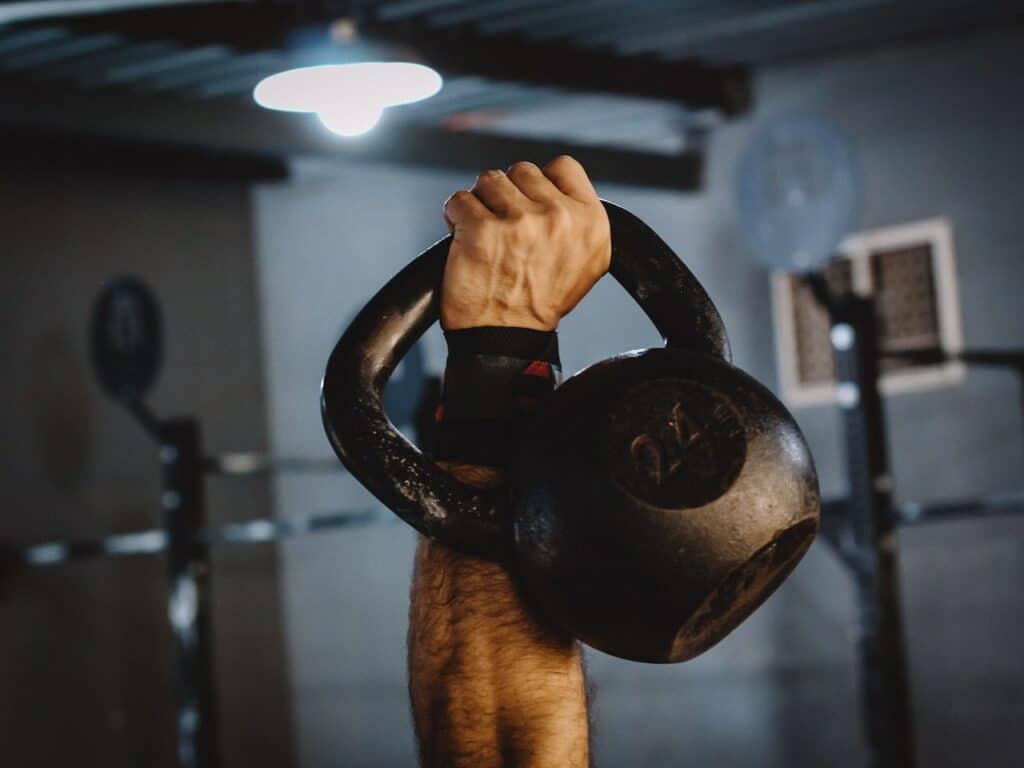
Kettlebell Thruster Workout Examples
“5 Minutes of Hell”
Short, sweet, but brutal! If you’re short on time, this is an excellent way to get a great workout in just a few minutes.
- Round 1: 15 thrusters, 15 swings, rest for the remainder of the minute
- Round 2: 15 thrusters, 15 swings, rest for the remainder of the minute
- Round 3: 8 thrusters and 8 swings in 30 seconds, repeat x 3
- Round 4: 30-second AMRAPs, thrusters and swings
“Nasty Bells”, Luke Downing
Try this one when you want a challenge! Score yourself by your total time at the end of the full session.
- Round 1: 21 thrusters, 21 bell-facing burpees, for time
- Round 2: 18 thrusters, 18 bell-facing burpees, for time
- Round 3: 12 thrusters, 12 bell-facing burpees, for time
- Round 4: 9 thrusters, 9 bell-facing burpees, for time
- Round 4: 6 thrusters, 6 bell-facing burpees, for time
Round 4: 3 thrusters, 3 bell-facing burpees, for time

